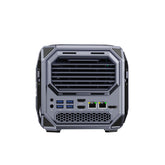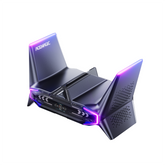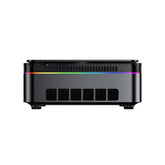Laptop Battery Indicator Light Blinking or Is Off? How to Solve It

An indicator light on the laptop battery provides real-time feedback on charging. When it starts to blink or is not lit, users wonder whether their battery, charger, or laptop has a fault. These symptoms usually reflect power supply issues, battery faults, or internal errors.
This guide describes what happens when your laptop charging light flashes or does not come on, and provides useful tips on how to repair it and have normal charging again.
Why Is Your Laptop Charging Light Blinking?
When your laptop charging light flashes, it typically suggests that the system is struggling to charge the battery. The most common reasons are:
-
Adapter problems: An underpowered or incompatible adapter may provide unstable current.
-
Battery near death: Aging batteries lose the ability to be charged, which may trigger blinking lights.
-
Loose battery connection: In laptops with removable batteries, loose connections may interrupt charging detection.
-
Overheating: Excessive temperatures can halt charging to avoid battery damage.
-
Driver or BIOS failures: Absent or outdated firmware may interfere with battery recognition.
Each of these issues affects how the system handles charging and can usually be fixed with targeted actions.
What If the Charging Light Doesn't Turn On?
When the battery light remains off despite having the charger plugged in, the laptop is not getting power. Some causes are:
-
The charger is broken or disconnected
-
The charging port is blocked with dirt or is damaged
-
The battery is drained to zero and not getting charged
-
The internal charging circuit has failed
A flashing powered-off charging light typically signifies a more serious issue than a dead one and may require diagnosis through power supply testing or hardware inspection.
How to Fix a Blinking or Dead Battery Light
Here are effective steps to resolve the charging light problem:
1. Check the Charger and Outlet
-
Insert the charger firmly into the wall and the laptop.
-
Test another outlet to rule out socket malfunctions.
-
Use a compatible charger that matches your laptop’s voltage and current.
-
Ensure the charger is manufacturer-supported.
-
Inspect the cable for damage, fraying, or overheating.
Tip: Most charging issues originate from faulty adapters or inadequate power delivery.
2. Check the Charging Port and Cable
-
Use a flashlight to inspect for dust, lint, or bent pins.
-
Clean the port gently using compressed air or a soft tool.
-
Ensure the connector fits snugly and doesn’t wiggle.
-
Avoid pulling or twisting the cable while charging.

3. Reboot with Charger Plugged In
-
Shut down the laptop.
-
Plug in the charger.
-
Turn it back on and watch the indicator light.
This often resolves temporary detection issues.
4. Remove and Reinsert the Battery (if removable)
-
Shut down and remove the battery.
-
Press and hold the power button for 15 seconds.
-
Reinsert the battery, connect the charger, and power up.
This helps reset the battery’s connection.
5. Run a Battery Report (Windows)
-
Open Command Prompt as Admin.
-
Type:
powercfg /batteryreport -
Open the generated HTML file in your user folder.
-
Review charge cycles, capacity trends, and battery health.

6. Update Battery Drivers and BIOS
-
Open Device Manager → Batteries → Right-click and update drivers.
-
Restart your system.
-
Visit your laptop manufacturer’s support site for BIOS updates.
-
Download and follow update instructions.
Important: Back up files before updating BIOS and plug in the charger to avoid power loss.
7. Cool Down the Laptop
-
Shut off the laptop.
-
Place it in a ventilated and cool space.
-
Resume charging after 10–20 minutes.
Overheating often pauses charging as a protection measure.
8. Check Charging While Laptop Is Powered Off
-
Turn off the laptop completely.
-
Plug in the charger.
-
Check if the light blinks or turns solid.
This test helps rule out OS-related interference.
9. Perform a Hard Reset (Certain Models)
-
Locate the reset pinhole at the back.
-
Use a paperclip to press and hold it for 10–15 seconds.
-
Plug in the charger and power the device back on.
Check your user manual to confirm availability of this function.
10. Get a Professional Inspection
If none of the above works, the problem could be:
-
A dead battery that requires replacement.
-
Charging IC failure or power chip malfunction.
-
Motherboard damage.
A technician can diagnose and suggest appropriate repair or replacement.
Battery Maintenance Tips to Prevent Charging Issues
Reduce your chances of future charging issues with these best practices:
-
Avoid deep discharges: Maintain battery between 20–80%.
-
Use original or certified chargers.
-
Keep the laptop cool: Avoid direct heat and poor airflow.
-
If storing long-term: Leave battery at 40–60% and unplug.
-
Update BIOS/firmware regularly.
-
Use the battery sometimes: Don’t leave it always plugged in.

Frequently Asked Questions (FAQ)
Is a blinking battery light normal?
It’s a warning sign, not a danger—usually indicating charging issues or a faulty battery.
How long do laptop batteries last?
Typically 2–4 years or 300–500 cycles. Aging shows in capacity drops and erratic charging.
Can software cause charging problems?
Yes. Drivers, firmware, or calibration issues can interrupt detection.
Should I replace the battery or charger first?
Test a working charger first. If problems remain, then test or replace the battery.
Is BIOS update safe?
Yes—if done from the official support site, with files saved and the charger connected.
Conclusion
A blinking or unlit charging light is typically linked to power delivery problems, battery wear, or outdated firmware. Try cleaning the port, using a compatible charger, updating drivers, or checking battery health reports.
If these don’t work, a technician can help identify whether a battery replacement or deeper repair is needed.
By following healthy charging practices and keeping your system up to date, you can extend your laptop battery’s life and avoid future charging headaches.







Leave a comment
Please note, comments need to be approved before they are published.